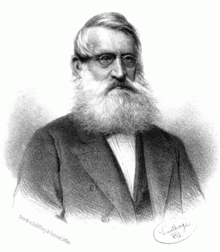Ferdinand Schur

Philipp Johann Ferdinand Schur (born February 18, 1799 in Königsberg ; † May 27, 1878 in Bielitz , Austrian-Silesia ) was an East Prussian , German- k. k. Austrian botanist , chemist and manufacturer . Its botanical author abbreviation is " Schur ".
life and work
Schur grew up as the son of a button maker. At the age of ten he entered the Kneiphof'sche Dom-Gymnasium. When this was converted into a higher middle school, he intended to prepare privately for the academic student examination. However, the family's financial means were not sufficient. Schur now chose pharmacy as his profession and joined the Wegener'sche pharmacy in Gerdauen as an apprentice . During his apprenticeship he already set up a herbarium of 600 plants. In 1819 he passed the assistant examination and worked in this pharmacy until 1826. From 1821 he lived in Königsberg again and, depending on his financial possibilities, switched between the assistant position and the study. Schur had studied pharmacy , chemistry in all disciplines, physics , mineralogy , zoology , botany and philosophy at the Königsberg and Berlin universities for five years . He studied in Königsberg with Friedrich Dulk , Ernst Meyer and Friedrich Burdach , among others ; in Berlin with Alexander von Humboldt , Eilhard Mitscherlich and Sigismund Friedrich Hermbstädt . He finished his studies as a first class pharmacist in 1831 and received his doctorate from the University of Jena in 1835 . Schur then offered private lessons in chemistry, chemical analysis, pharmacy and botany.
In 1831 Schur went to Liesing near Vienna as director of a chemical factory . He now immersed himself in chemical-technical studies, but remained connected to botany. He subsequently worked for the Austrian botanical journal . In 1839, Schur founded a chemical factory in Inzersdorf am Wienerberg , which, like some of the following companies, failed to achieve economic success. Schur settled in Pressburg and St. Georgen in Hungary . In 1845 Schur took over the management of a chemical factory in Sibiu in Transylvania for eight years .
On behalf of the then governor of Transylvania, Prince Karl zu Schwarzenberg , Schur traveled through the Transylvanian countryside in 1853 to complete his research with a scientific, actually botanical tour at state expense. He was accompanied by the young naturalist Eduard Albert Bielz (1827–1898). The comprehensive travel report was published in 1859. On his numerous excursions, Schur created a herbarium with over 50,000 plant specimens, which served as the basis for his scientific work.
In 1854 Schur returned to Vienna and from 1872 lived in Brunn am Gebirge . In 1876 he moved to his son, who had taken over a parish in Bielitz. There he died of complications from pneumonia.
- Plants described by Ferdinand Schur
literature
- Constantin von Wurzbach : Schur, Johann Ferdinand . In: Biographisches Lexikon des Kaiserthums Oesterreich . 32nd part. Imperial-Royal Court and State Printing Office, Vienna 1876, p. 220 f. ( Digitized version ).
- Franz Speta: Dr. Ferdinand Schur. Life and work of Ferd. Shear. Stapfia 1994, 334 pages, PDF on ZOBODAT
- Schur, Ferdinand. In: Austrian Biographical Lexicon 1815–1950 (ÖBL). Volume 11, Verlag der Österreichischen Akademie der Wissenschaften, Vienna 1999,ISBN 3-7001-2803-7, p. 375 f. (Direct links on p. 375 , p. 376 ).
Web links
- Literature by and about Ferdinand Schur in the catalog of the German National Library
- Austrian botanical journal
- Author entry and list of the described plant names for Ferdinand Schur at the IPNI
Individual evidence
- ↑ Béla Köpeczi (ed.): Brief history of Transylvania. 1. Introduction of arbitrary rule
- ↑ Bronisław Błocki: Remarks about some plants of Schur's "Herbarium transsilvanicum". Plant Systematics and Evolution, Vol. 31, No. 5, May 1881, doi : 10.1007 / BF01637761 .
| personal data | |
|---|---|
| SURNAME | Schur, Ferdinand |
| ALTERNATIVE NAMES | Schur, Johann Ferdinand; Schur, Phil. Johann Ferdinand; Schur, Philipp Johann Ferdinand |
| BRIEF DESCRIPTION | German-Austrian botanist, chemist and manufacturer |
| DATE OF BIRTH | February 18, 1799 |
| PLACE OF BIRTH | Koenigsberg |
| DATE OF DEATH | May 27, 1878 |
| Place of death | Bielitz , Austrian Silesia |



